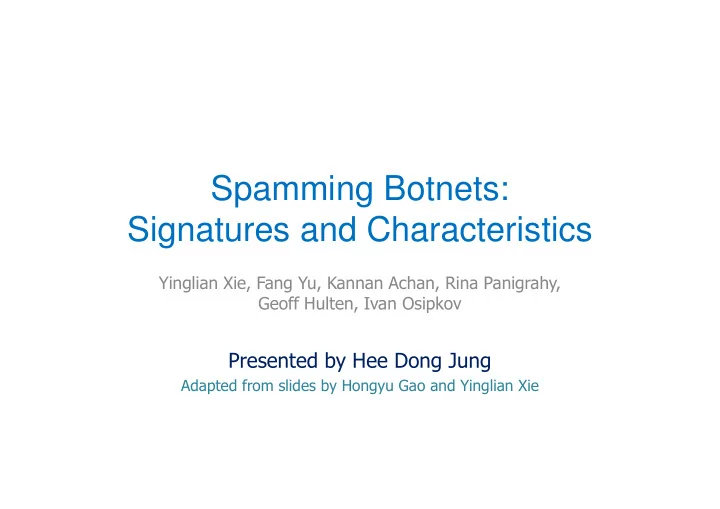

Spamming Botnets: Signatures and Characteristics �������� �������������������� ����������� ����������� �������������������������� �������� �!����� "����#��� � ���� ����$���� ���!�������� ��� �� ��������� ���
Motivation • Botnets have been widely used for sending spam emails at a large scale • Detection and blacklisting is difficult as: – Each bot may send only a few spam emails – Each bot may send only a few spam emails – Attacks are transient in nature • Little effort devoted to understanding aggregate behaviors of botnets from perspective of large email servers 2
Methodology • Use email dataset from a large email service provider (MSN Hotmail) • Focus on URLs embedded in email content content • Derive signatures for spam based on URLs • Detect spam using signatures and find out characteristics of botnets 3
Methodology • Challenges: – Random, legitimate URLs are added – URL obfuscation technique (polymorphic URLs, Redirection) 4
AutoRE Is there a way to circumvent any of these steps? 5
Automatic URL Regular Expression Generation • Signature Tree Construction • Regular Expression Generation – Detailing � Generalization 6
Datasets and Results • Able to identify spam emails and related botnet hosts (IP addresses / ASes)
AutoRE Performance • Low False Positive Rate (between 0.0015 and 0.0020) • Regular expressions reduce false positive rates by a factor of 10 to 30 • After generalization, AutoRE can detect 9.9 to 20.6% more spam without affecting false positive rates more spam without affecting false positive rates 8
Spamming Botnet Characteristics • Botnet IP addresses are spread across a large number of Ases • 69% of botnet IP addresses are dynamic IPs; more than 80% of campaigns have at least half their hosts in dynamic IP ranges dynamic IP ranges 9
Spamming Botnet Characteristics • Comparison of Different Campaigns – It is uncommon for different spam campaigns to overlap • Correlation with Scanning Traffic – Amount of scanning traffic in Aug is higher than in Nov, when botnet IPs were used to send spam – Suggests that botnets could have different phases 10
Discussion and Conclusion • AutoRE has potential to work in real-time mode • Leverages bursty and distributed features of botnet attacks for detection • Major Findings • Major Findings – Botnet hosts are widespread across Internet, with no distinctive sending patterns when viewed individually – Existence of botnet spam signatures and feasibility of detecting botnet hosts using them – Botnets are evolving and getting increasingly sophisticated 11
Discussion Points • Do you think “Bursty” and “Distributed” properties represent the spam emails? – Are there other properties that should be considered? considered? • When would this URL based approach not work? 12
Thank you Questions? 13
AutoRE • Framework for automatically generating URL signatures • Takes set of unlabeled email messages, produces 2 outputs: – Set of spam URL signatures – Set of spam URL signatures – Related list of botnet host IP addresses • Iteratively selects spam URLs based on distributed yet bursty property of botnets- based spam campaigns • Uses generated spam URL signatures to group emails into spam campaigns 14
Group Selector (backup) • Explores the bursty property of botnet email traffic • Construct n time windows • S(k) is defined as the total number of IP • S i (k) is defined as the total number of IP addresses that sent at least one URL in group i in window k • URL groups with sharp spikes are higher ranked 15
Automatic URL Regular Expression Generation (backup) • Signature Quality Evaluation – Quantitatively measures quality of signature and discards signatures that are too general – Metric: entropy reduction • Leverages on information theory to quantify probability of a • Leverages on information theory to quantify probability of a random string matching a signature • Given a regular expression e, let B e (u) and B(u) denote expected # bits to encode a random string u with and without signature • Entropy reduction d(e) = B(u)-B e (u) reflects probability of arbitrary string with expected length allowed by e and matching e, but not encoded using e 16
Botnet Validation • Verify if each spam campaign is correctly grouped together by computing similarity of destination Web pages • Web pages pointed to by each set of • Web pages pointed to by each set of polymorphic URLs are similar to each other, while pages from different campaigns are different.
Spamming Botnet Characteristics • For each campaign, standard deviation (std) of spam email sending time is computed – 50% of campaigns have std less than 1.81 hours – 90% of campaigns have std less than 24 hours and likely located at different time zones located at different time zones • For each campaign, host sending patterns are generally well-clustered – Number of recipients per email – Connection rate • Botnet hosts do not exhibit distinct sending patterns for them to be identified 18
Recommend
More recommend